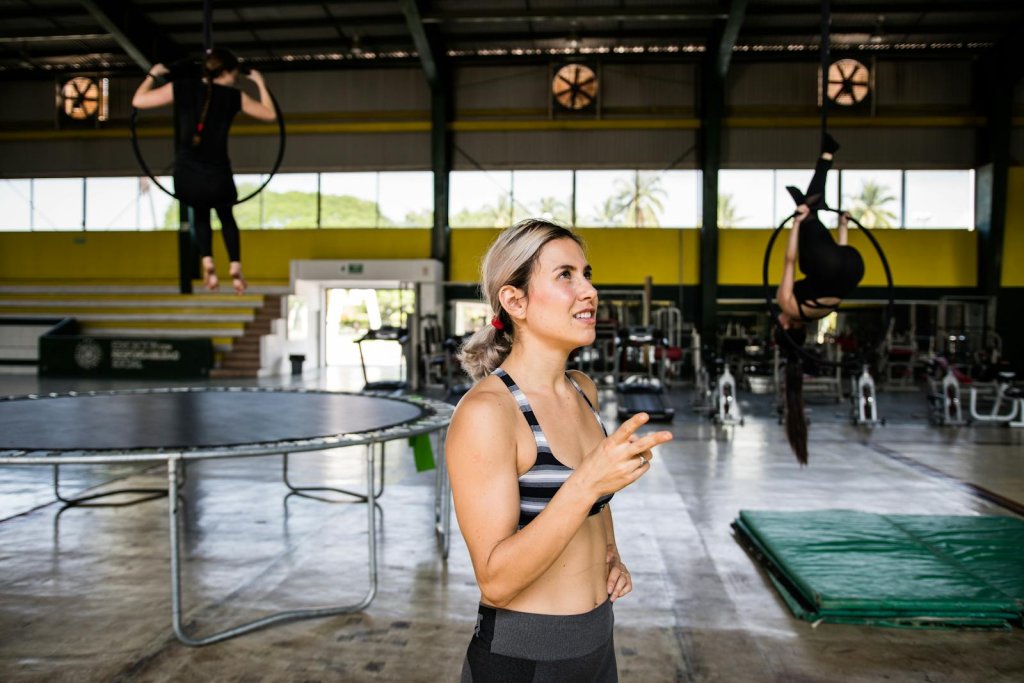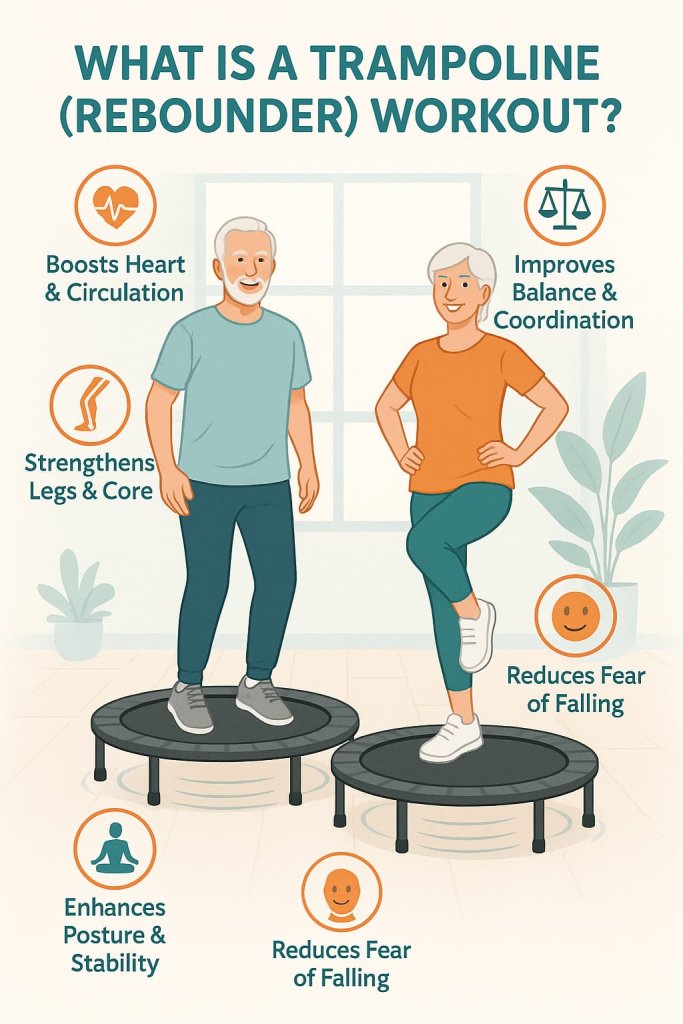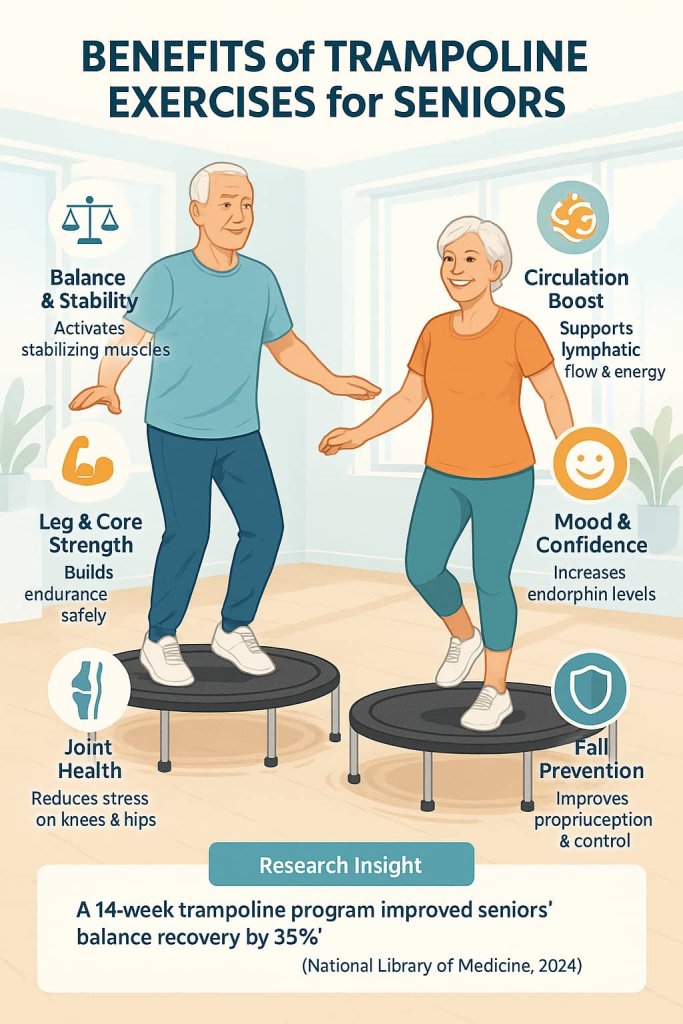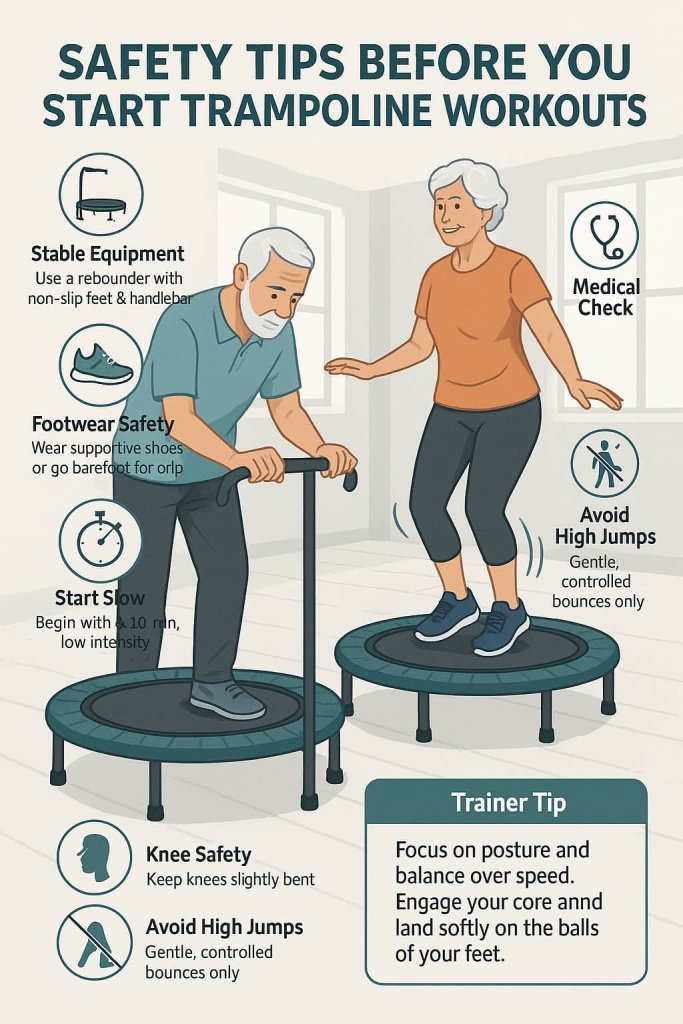Yes — trampoline exercises are safe and highly effective for seniors when done correctly.
They provide a low-impact way to build balance, strength, and mobility without stressing the joints. Mini-trampoline (or rebounder) workouts help improve circulation, coordination, and bone health — all while keeping fitness fun and safe at any age.

According to Cleveland Clinic (2024), rebounding can improve balance and leg strength by up to 35% in older adults. It’s also joint-friendly, supports lymphatic flow, and boosts overall vitality — making it one of the best low-impact workouts for seniors.
What Is a Trampoline (Rebounder) Workout?
A rebounder is a small, sturdy mini-trampoline designed for fitness use. Unlike backyard trampolines, rebounders are made for controlled, gentle bouncing — ideal for improving balance, posture, and cardiovascular health.

Randomized and controlled studies show that mini-trampoline (rebounder) training can improve balance, gait, strength, and functional mobility in older adults, with reductions in fear of falling.
Benefits of Trampoline Exercises for Seniors
- Improves balance and stability — activates the body’s stabilizing muscles.
- Strengthens legs and core — builds endurance without high impact.
- Supports joint health — cushioned bounce reduces stress on knees and hips.
- Boosts circulation and lymphatic flow — aids detoxification and energy.

- Enhances mood and confidence — increases endorphin levels naturally.
- Reduces fall risk — improves proprioception (body awareness).
Research Insight: A 14-week trampoline program improved seniors’ balance recovery ability by 35% and reduced fear of falling, according to the National Library of Medicine (2024).
Safety Tips Before You Start
Before beginning any trampoline exercise:
- Use a stable rebounder with non-slip feet and a safety handlebar.
- Wear supportive footwear or go barefoot for better grip.

- Start slow — short sessions (5–10 minutes) and low-intensity movements.
- Keep knees slightly bent to absorb impact safely.
- Avoid deep jumps — gentle, controlled bounces are enough.
- Consult your doctor if you have joint, heart, or balance issues.
Trainer Tip: Focus on posture and balance over speed. Engage your core and land softly on the balls of your feet.
10 Best Trampoline Exercises for Seniors
Stay active, improve balance, and boost confidence with these 10 safe, low-impact trampoline exercises designed specifically for seniors. Each move strengthens your core, legs, and stability while being gentle on the joints.
1. Basic Health Bounce
Why it works:
The health bounce gently activates the body’s circulation, warms up muscles, and stimulates the lymphatic system without any strain on the joints. It improves blood flow and prepares the body for more dynamic movements while easing stiffness in the knees, ankles, and hips.
Muscles worked:
Legs, calves, ankles, and stabilizing muscles around the knees and core.
How to do it:
- Stand tall in the center of the trampoline with your feet shoulder-width apart.
- Keep your knees slightly bent and your arms relaxed at your sides.
- Begin bouncing softly, letting your heels lift just slightly off the mat.
- Continue the gentle rhythm for 1–2 minutes while breathing steadily.
Trainer Tip:
Focus on maintaining posture and rhythm rather than height. Keep your head still and let the bounce do the work — this promotes joint safety and balance control.
2. March in Place
Why it works:
Marching on the trampoline challenges coordination and strengthens the legs and hips while promoting balance and core activation. It’s also an excellent cardiovascular warm-up for seniors.
Muscles worked:
Quadriceps, hamstrings, hip flexors, glutes, and core.
How to do it:
- Stand in the center of the trampoline and begin lifting one knee at a time in a marching motion.
- Keep your back straight and swing your arms naturally for balance.
- March slowly at first, then increase rhythm as you gain stability.
- Continue for 1–2 minutes, rest, and repeat.
Trainer Tip:
If you feel wobbly, lightly hold the safety handlebar or place one hand on a sturdy surface for balance support.
3. Side-to-Side Steps
Why it works:
This movement improves lateral balance and coordination — two key factors in fall prevention. It also activates the outer thighs and hips, which often weaken with age.
Muscles worked:
Hip abductors, adductors, glutes, thighs, and core stabilizers.
How to do it:
- Start with your feet together in the center of the trampoline.
- Step your right foot out to the side, then bring your left foot to meet it.
- Repeat to the left side, maintaining a smooth rhythm.
- Keep your knees soft and your chest upright.
- Move for 30–45 seconds, rest, then repeat.
Trainer Tip:
Focus on control rather than speed. Keep your movements light and steady to build confidence and coordination.
4. Heel Digs
Why it works:
Heel digs strengthen the back of your legs and improve lower-body coordination. This simple yet effective move also boosts blood flow to the calves and hamstrings.
Muscles worked:
Hamstrings, calves, and glutes.
How to do it:
- Stand with your feet hip-width apart.
- Extend one leg forward and tap your heel gently into the mat.
- Alternate legs in rhythm with a light bounce.
- Keep your core tight and shoulders relaxed.
- Perform 15–20 repetitions per leg.
Trainer Tip:
Maintain a light bounce between taps — this keeps your momentum and improves circulation without strain.
5. Gentle Jog
Why it works:
A low-impact way to boost heart rate and endurance, the gentle jog helps improve cardiovascular fitness, coordination, and leg strength while protecting the joints.
Muscles worked:
Quadriceps, hamstrings, calves, and core.
How to do it:
- Begin with a slow march, then gradually increase your pace into a light jog.
- Keep your knees softly bent and your landings light.
- Swing your arms naturally to maintain balance.
- Jog for 1 minute, rest, then repeat twice.
Trainer Tip:
If you’re new to jogging, start with shorter intervals and focus on smooth landings — avoid bouncing too high.
6. Front-to-Back Hops
Why it works:
This controlled motion enhances dynamic balance, coordination, and reaction time — crucial for preventing falls and maintaining mobility as you age.
Muscles worked:
Quads, glutes, calves, core, and spinal stabilizers.
How to do it:
- Stand at the center of the trampoline with feet hip-width apart.
- Gently hop forward 4–6 inches, then back to your starting point.
- Keep movements soft and controlled.
- Repeat continuously for 30 seconds.
Trainer Tip:
Concentrate on your landing form — knees slightly bent, feet flat, and abs engaged. Small, smooth hops are safer and more effective than large jumps.
7. Twists
Why it works:
Twists improve core strength, spine mobility, and coordination. They also engage the oblique muscles, helping to support posture and balance.
Muscles worked:
Obliques, abdominals, lower back, and hips.
How to do it:
- Stand in the center of the trampoline with soft knees.
- Twist your hips gently from side to side while keeping your shoulders facing forward.
- Maintain an upright torso and a light bounce.
- Continue for 30–45 seconds.
Trainer Tip:
Move slowly at first — focus on controlled twisting, not speed. Keep breathing steady throughout.
8. Single-Leg Balance
Why it works:
This move builds stability, strengthens ankle muscles, and enhances proprioception — the body’s ability to sense movement and position — which helps prevent falls.
Muscles worked:
Ankles, calves, glutes, and core stabilizers.
How to do it:
- Stand tall in the center and lift one foot off the trampoline slightly.
- Balance on the other leg for 10–20 seconds.
- Switch legs and repeat.
- Keep your gaze on a fixed point ahead for focus.
Trainer Tip:
Hold the handlebar if needed. Gradually reduce your grip as balance improves — this encourages natural coordination and ankle strength.
9. Mini Squats
Why it works:
Squats strengthen the legs and glutes, improve knee stability, and promote proper movement patterns for daily activities like standing or climbing stairs.
Muscles worked:
Quads, glutes, hamstrings, and core.
How to do it:
- Stand with your feet shoulder-width apart.
- Lower your body into a shallow squat, keeping your chest up and core tight.
- Press through your heels to rise back up.
- Perform 10–15 repetitions.
Trainer Tip:
Move slowly and control your depth. The trampoline’s soft surface challenges your balance — which builds more stabilizer strength.
10. Cool-Down Bounce
Why it works:
Cooling down allows the heart rate to return to normal, helps muscles relax, and promotes circulation for faster recovery. It’s an excellent way to end your trampoline session gently.
Muscles worked:
Full body — particularly legs, calves, and core.
How to do it:
- Stand upright with feet hip-width apart.
- Perform slow, relaxed bounces for 2–3 minutes.
- Inhale deeply through your nose and exhale slowly through your mouth.
- Allow your arms to swing naturally at your sides.
Trainer Tip:
Use this time to slow your breathing and stretch your legs or shoulders after the bounce. It’s a mindful transition from exercise to rest.
Suggested Routine for Seniors
| Level | Duration | Frequency | Focus |
|---|---|---|---|
| Beginner | 10–15 minutes | 2–3 days/week | Balance & coordination |
| Intermediate | 20 minutes | 3–4 days/week | Strength & stability |
| Advanced | 25–30 minutes | 4–5 days/week | Endurance & posture |
Common Mistakes to Avoid
- Jumping too high or landing stiffly
- Skipping warm-up or cool-down
- Ignoring safety handles or unstable surfaces
- Wearing slippery shoes
- Overtraining without rest days
FAQs About Trampoline Workouts for Seniors
1. Are trampoline workouts safe for seniors with arthritis?
Yes — rebounders reduce joint impact compared to walking or jogging. However, use soft bounces and consult your doctor first.
2. How often should seniors use a trampoline?
Start with 2–3 short sessions per week (10–15 minutes), gradually increasing as comfort improves.
3. What type of trampoline is best for seniors?
A mini-trampoline (rebounder) with handlebar support and firm, non-slip mat is ideal.
4. Can trampoline exercise help with bone health?
Yes — light bouncing is a weight-bearing activity that supports bone density and prevents osteoporosis.
5. What muscles do trampoline exercises work?
They engage the legs, glutes, core, and stabilizers, improving strength and posture.
6. Can I lose weight with trampoline workouts?
Yes. A 20-minute rebounding session can burn 200–300 calories, depending on intensity.
7. Do I need prior exercise experience?
No. Start with simple balance bounces — these are suitable even for beginners.
Conclusion
Trampoline exercises for seniors are a safe, low-impact, and enjoyable way to stay active, improve balance, and enhance longevity. Regular rebounding supports joint health, muscle tone, and confidence — all essential for healthy aging.
Start slow, stay consistent, and bounce your way to better health.
This content is for informational purposes only and not medical advice.
References
- U.S. guidelines for adults 65+ — at least 150 min/week moderate activity, 2+ days strength, and regular balance work (basis for your weekly plan).
CDC: Physical Activity Guidelines for Older Adults - What counts as activity for older adults — clarifies examples and includes balance-training emphasis.
CDC: What Counts as Physical Activity for Older Adults - Mini-trampoline vs. other exercise for postural balance — shows postural balance benefits of mini-trampoline compared with alternatives.
Effect of Different Types of Exercise on Postural Balance in Elderly Women (de Oliveira et al., 2014) - High-impact mini-trampoline protocol (SuperJump) — evidence of positive effects on bone metabolism (relevant to bone health framing).
The Effect of the New High-Impact Activity “SuperJump” on Bone Metabolism (Vasto et al., 2021) - Dynamic stability training and fall recovery in older adults — supports inclusion of balance/reactive elements (front-back hops, single-leg work).
Exercising Mechanisms for Dynamic Stability Control in Old Adults (Arampatzis et al., 2010) - Benefits overview for 65+ — immediate and long-term health benefits of regular activity (sleep, blood pressure, chronic disease prevention).
CDC: Physical Activity Benefits for Adults 65 or Older
